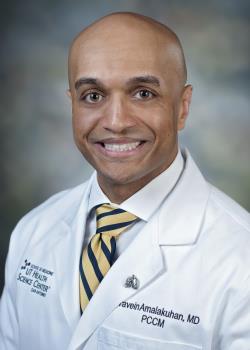Physical Fitness and Health During Fellowship
May 11, 2016
This post is a part of our Life as a Fellow blog post series. This series includes "fellow life lessons" from current trainees in leadership with CHEST.
The alarm sounded, and I quickly turn it off knowing that it is time to wake up for another busy day in the ICU. That night was certainly busy, being filled with many calls regarding new admissions and transfers. I notice that same nagging pain in my lower back as I get up to shower and prepare for the day ahead. That general feeling of weakness and lower back pain reminds me that I haven’t made it to the gym in over a month. I know there are endless excuses, but I’m so tired after work and just feel like I have so many things to do.
The rigors of a busy pulmonary and critical care fellowship, like many other demanding subspecialties, provides unique hurdles to maintaining an effective work-life balance. One aspect of this balance that does not receive much attention is the physical fitness of trainees. Many international health-care organizations recommend a minimum of 30 minutes of moderate-to-vigorous exercise per day, and on average 150 minutes per week. Current data suggest that most residents and fellows do not come close to this recommendation. Historically, the culture of medicine has perpetuated the belief that physicians are never ill but are the epitome of steadfast health. Although they face the same health problems as the general public, they often consider attention to their own health as a sign of weakness, as I did. This misperception has long-standing consequences. Practicing pulmonary and critical care medicine is a marathon in many respects, and maintaining one’s health is key to having a long and productive career. Health problems and injuries related to a lack of physical fitness can lead to early retirement and even impact earning potential.
The field of physician health is only in its infant stages but has largely focused on mental health and substance abuse. However, much less is known about their physical health, including injuries on the job or simply due to inactivity. Hurdles that physicians face include prolonged sleep deprivation and poor eating habits due to erratic schedules. Further adding to these hurdles is the false belief that a long day of clinical duties with walking is productive and clinically impactful to their health. Leading the charge is the Royal College of Physicians and Surgeons of Canada who have added “self-care” as a core competency, expecting their physicians to demonstrate a commitment to self-health and sustainable practice.
Shortly thereafter, I decided to commit to going to the gym six days per week, for at least 30 minutes per day, regardless of how busy that day or night was. I even got a personal trainer. After 2 months, I no longer experienced back pain after a long shift, after six months I lost 15 pounds, and after a year I could run a mile in just seven minutes. Many other fellows and staff now join me as well at the same gym. On one Monday evening at 7:30 pm as I passed by various equipment stations during my workout routine, I noticed another fellow with my personal trainer on one of the machines. I nod and smile at him. Both of us are no longer making any excuses as we make fitness and health as important as any other aspect of our lives and professional obligations. Jim Rohn captured this concept well when he said, “there are two types of pain you will go through in life, the pain of discipline/change and the pain of regret…discipline and change weighs ounces, while regret weighs tons.”
 Dr. Bravein Amalakuhan is a graduate of St. George’s University School of Medicine, and after completing his Internal Medicine training at the Pinnacle Health Hospitals Network in Harrisburg-Hershey PA, he completed a Cardiovascular Surgical Critical Care Fellowship at Johns Hopkins University. He is currently in his second year as a Pulmonary and Critical Care Medicine Fellow at the University of Texas Health Science Center at San Antonio.
Dr. Bravein Amalakuhan is a graduate of St. George’s University School of Medicine, and after completing his Internal Medicine training at the Pinnacle Health Hospitals Network in Harrisburg-Hershey PA, he completed a Cardiovascular Surgical Critical Care Fellowship at Johns Hopkins University. He is currently in his second year as a Pulmonary and Critical Care Medicine Fellow at the University of Texas Health Science Center at San Antonio.